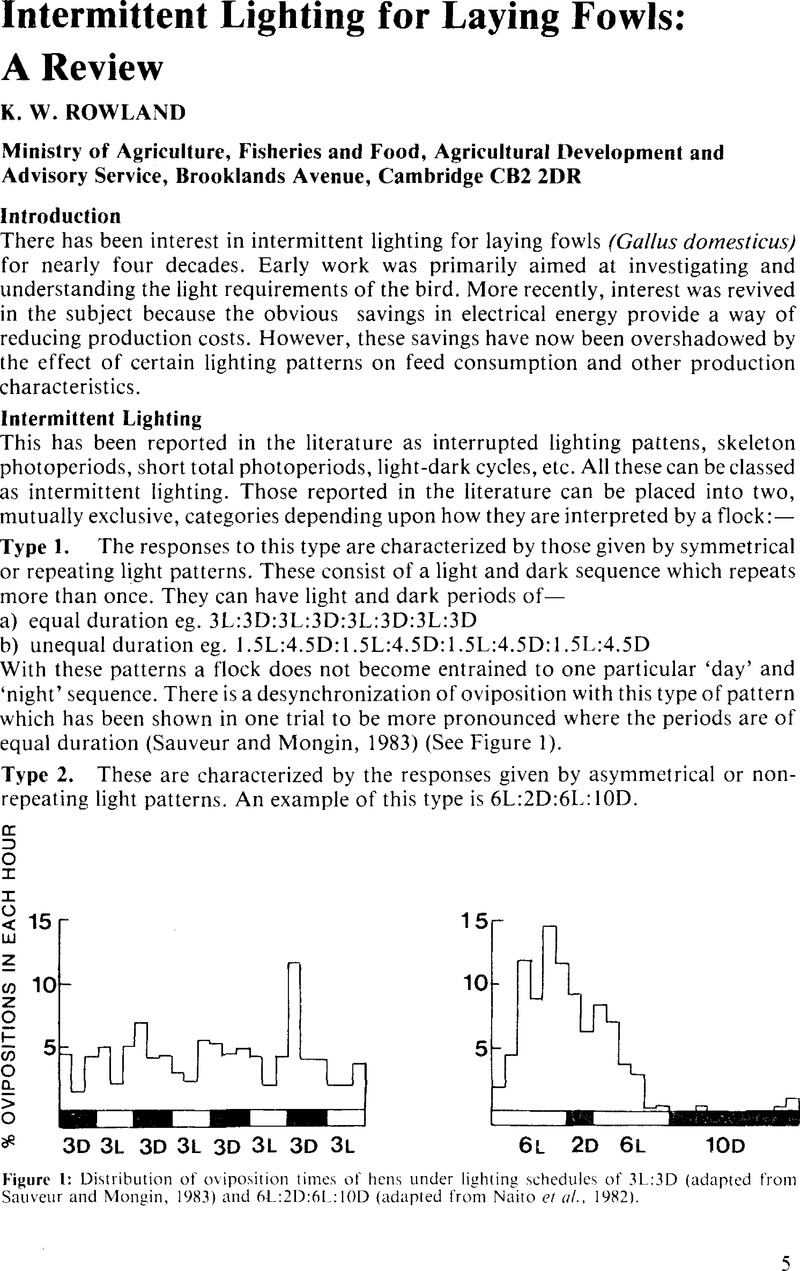Crossref Citations
This article has been cited by the following publications. This list is generated based on data provided by Crossref.
KOELKEBECK, K.W.
and
BIELLIER, H.V.
1986.
Ahemeral Light-Dark Cycles and Intermittent Photoperiod Effects on Laying Hens ,.
Poultry Science,
Vol. 65,
Issue. 11,
p.
2002.
Ernst, R. A.
Milliam, J. R.
and
Mather, F. B.
1987.
Review of life-history lighting programs for commercial laying fowls.
World's Poultry Science Journal,
Vol. 43,
Issue. 1,
p.
45.
Midgley, M.
Morris, T. R.
and
Butler, E. A.
1988.
Experiments with the bio‐mittent lighting system for laying hens1.
British Poultry Science,
Vol. 29,
Issue. 2,
p.
333.
Slaugh, B.T.
Johnston, N.P.
Patten, J.D.
and
White, G.W.
1988.
Effects of photoperiod and intermittent lighting on reproduction in pheasant hens.
Theriogenology,
Vol. 30,
Issue. 2,
p.
291.
Morris, T. R.
Midgley, M.
and
Butler, E. A.
1988.
Experiments with the Cornell intermittent lighting system for laying hens.
British Poultry Science,
Vol. 29,
Issue. 2,
p.
325.
Cunningham, D. L.
1988.
Comparison of the Cornell and bio‐mittent reduced lighting programmes for laying hens.
British Poultry Science,
Vol. 29,
Issue. 2,
p.
265.
MacLeod, M. G.
Jewitt, T. R.
and
Anderson, Julie E. M.
1988.
Energy expenditure and physical activity in domestic fowl kept on standard and interrupted lighting patterns.
British Poultry Science,
Vol. 29,
Issue. 2,
p.
231.
SIOPES, T.D.
and
PYRZAK, R.
1990.
Effect of Intermittent Lighting on the Reproductive Performance of First-Year and Recycled Turkey Hens ,.
Poultry Science,
Vol. 69,
Issue. 1,
p.
142.
Triyuwanta
and
Nys, Y.
1990.
Effects of short intermittent lighting on food consumption and performance of dwarf broiler breeders and progeny.
British Poultry Science,
Vol. 31,
Issue. 3,
p.
603.
Tucker, S. A.
and
Charles, D. R.
1993.
Light intensity, intermittent lighting and feeding regimen during rearing as affecting egg production and egg quality.
British Poultry Science,
Vol. 34,
Issue. 2,
p.
255.
Boshouwers, F. M. G.
and
Nicaise, Elly
1993.
Artificial light sources and their influence on physical activity and energy expenditure of laying hens.
British Poultry Science,
Vol. 34,
Issue. 1,
p.
11.
Morris, T. R.
and
Butler, E. A.
1995.
New intermittent lighting programme (the reading system) for laying pullets.
British Poultry Science,
Vol. 36,
Issue. 4,
p.
531.
Gewehr, Clóvis Eliseu
Cotta, Judas Tadeu de Barros
Oliveira, Antonio Ilson Gomes de
and
Freitas, Henrique Jorge de
2005.
Efeitos de programas de iluminação na produção de ovos de codornas (Coturnix coturnix).
Ciência e Agrotecnologia,
Vol. 29,
Issue. 4,
p.
857.
Freitas, Henrique Jorge de
Cotta, Judas Tadeu de Barros
Oliveira, Antonio Ilson Gomes de
and
Gewher, Clóvis Eliseu
2005.
Avaliação de programas de iluminação sobre o desempenho zootécnico de poedeiras leves.
Ciência e Agrotecnologia,
Vol. 29,
Issue. 2,
p.
424.
Cooper, Caren B.
Voss, Margaret A.
Ardia, Daniel R.
Austin, Suzanne H.
and
Robinson, W. Douglas
2011.
Light increases the rate of embryonic development: implications for latitudinal trends in incubation period.
Functional Ecology,
Vol. 25,
Issue. 4,
p.
769.
Borille, R
Garcia, RG
Royer, AFB
Santana, MR
Colet, S
Naas, IA
Caldara, FR
Almeida Paz, ICL
Rosa, ES
and
Castilho, VAR
2013.
The use of light-emitting diodes (LED) in commercial layer production.
Revista Brasileira de Ciência Avícola,
Vol. 15,
Issue. 2,
p.
135.
Jácome, IMTD
Rossi, LA
and
Borille, R
2014.
Influence of artificial lighting on the performance and egg quality of commercial layers: a review.
Revista Brasileira de Ciência Avícola,
Vol. 16,
Issue. 4,
p.
337.
Geng, A.L.
Zhang, Y.
Zhang, J.
Wang, H.H.
Chu, Q.
and
Liu, H.G.
2018.
Effects of lighting pattern and photoperiod on egg production and egg quality of a native chicken under free-range condition.
Poultry Science,
Vol. 97,
Issue. 7,
p.
2378.
Geng, A.L.
Zhang, J.
Zhang, Y.
Wang, H.H.
Chu, Q.
Yan, Z.X.
and
Liu, H.G.
2022.
Effects of lighting regimes on performance, pineal melanopsin expression and melatonin content in native laying hens aged from 19 to 34 weeks.
Poultry Science,
Vol. 101,
Issue. 1,
p.
101567.
Gharaoghlan, Mehdi Fayezi
Bagherzadeh-Kasmani, Farzad
Mehri, Mehran
and
Ghazaghi, Mahmoud
2022.
The effect of short, long, natural, and intermittent short photoperiods on meat-type Japanese quails.
International Journal of Biometeorology,
Vol. 66,
Issue. 9,
p.
1737.



